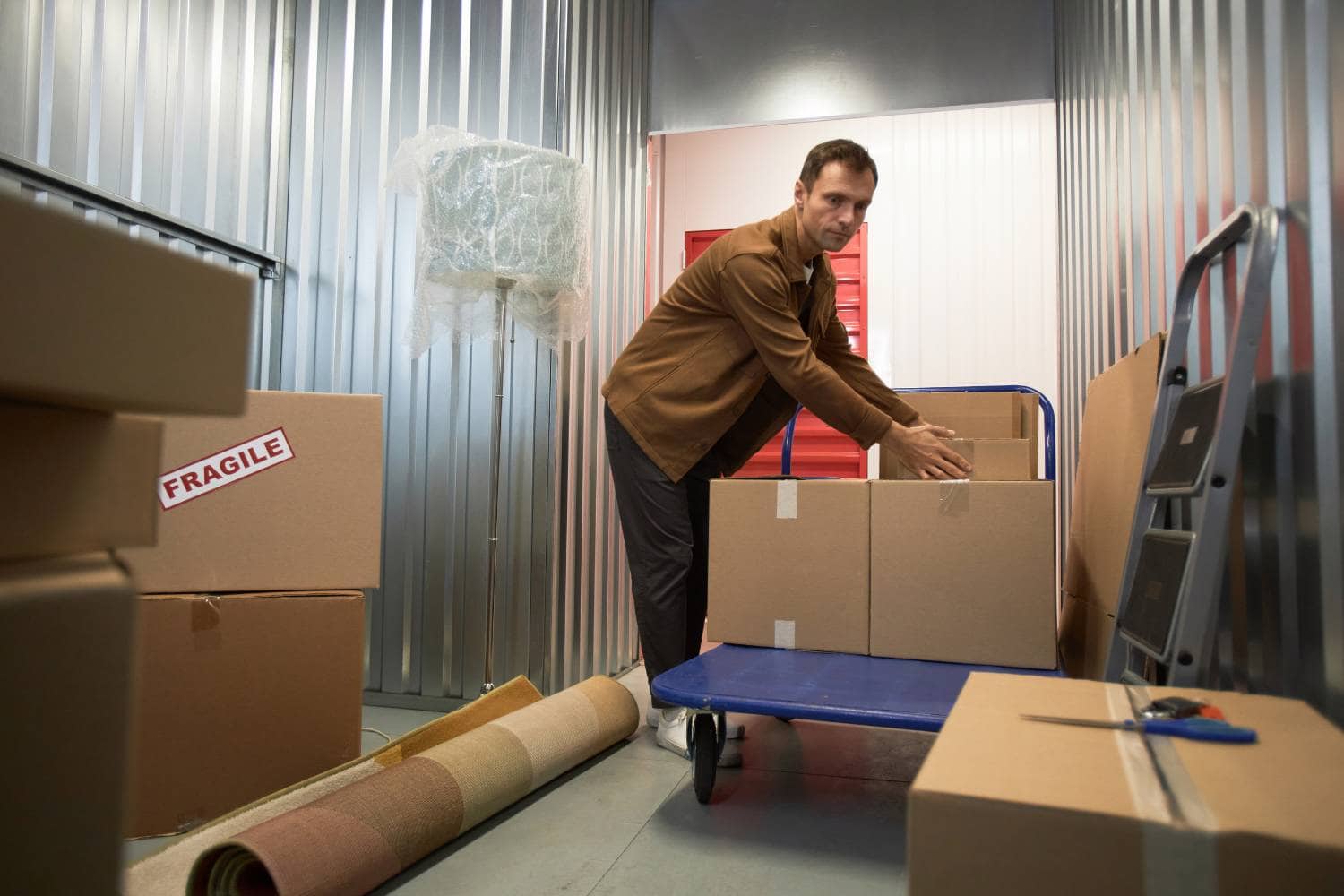Storage units are a practical solution for safeguarding your belongings, whether you’re decluttering your home, transitioning between spaces, or needing a makeshift workplace. However, pests such as mice, rodents, and insects can pose a serious threat, not only damaging your valuable items but also causing health hazards.
To avoid a potential infestation, it’s essential to take preventive measures to keep pests out of your storage unit. This guide provides useful tips on how to safeguard your storage unit from unwanted visitors, ensuring your possessions remain safe and undamaged.
Let’s get straight to the point
To keep pests out of your storage unit, follow these key steps: Inspect the facility for signs of pests before renting, avoid storing food, use airtight containers or properly sealed boxes, and cover furniture and mattresses. Regularly clean and inspect your unit for any signs of infestation.
Natural repellents like cedar blocks or essential oils can help, and consider professional pest control if necessary. Opt for facilities with good pest management and climate control, and ensure your belongings are insured against potential pest damage. Prevention is essential to safeguarding your valuables.

Why Pests Are a Problem in Storage Units
The Dangers of Pests in Storage Units
Pests like rodents and insects are naturally drawn to storage units due to the availability of dark, undisturbed spaces and, often, access to food. Unfortunately, pests can wreak havoc on your stored items.
Rodents are notorious for chewing through boxes, furniture, and wires, while insects can ruin textiles and even infest mattresses. Furthermore, pests can spread diseases through their droppings and create an unpleasant environment within the storage facility.
Even if your storage unit appears clean, it’s crucial to remember that pests can sneak in from adjacent units or even enter through tiny cracks and crevices. Hence, it’s essential to stay vigilant to avoid unexpected damage to your possessions.
Conduct a Thorough Inspection of the Storage Facility
Before renting a storage unit, take the time to inspect the facility thoroughly. Look out for any signs of pests, such as rodent droppings, dead insects, or garbage mismanagement. Storage facilities that are poorly maintained or located near potential food sources are more likely to experience pest problems.
Warning Signs to Watch For
When inspecting the facility, watch for overflowing bins, evidence of pest trails, or unsealed entry points where rodents or insects might enter. These are clear indicators that the facility might have a pest problem. Ensure the facility management practices pest control regularly and maintains a clean environment.
Avoid Storing Food in Your Unit
The most effective way to keep pests out of your storage unit is to avoid storing any food. Even small amounts of food, like crumbs or food remnants left in boxes, can attract pests. It’s common for people to overlook perishable items when moving, but food is a magnet for rodents and insects.
Inspect All Boxes for Food Residue
If you’re using boxes that previously contained food, ensure they are thoroughly cleaned before placing them in the storage unit. Vacuum the cushions of furniture to remove any crumbs and double-check all containers for traces of food residue. Even a faint smell can be enough to attract unwanted visitors.
Use Airtight Containers
Whenever possible, store your items in airtight containers rather than cardboard boxes. Plastic containers with tightly sealed lids are much more effective at keeping pests at bay. Unlike cardboard, plastic cannot be chewed through by rodents or insects, offering extra protection for your belongings.
Seal Cardboard Boxes Properly
If you must use cardboard boxes, ensure they are completely sealed with sturdy packing tape to prevent pests from entering. Also, avoid using previously used boxes, as they may have tears or holes that could allow pests easy access.
Protect Furniture and Mattresses
If you’re storing upholstered furniture or mattresses, make sure to cover them appropriately. Use plastic mattress covers to prevent pests from burrowing into them, and consider wrapping upholstered furniture in shrink wrap. This creates an extra layer of protection while still allowing your furniture to “breathe,” reducing the risk of moisture build-up.
Regularly Clean and Sweep Your Unit
Keeping your storage unit clean is one of the best ways to discourage pests. Even if you aren’t storing food, small amounts of dust, dirt, or crumbs can attract insects and rodents.
Maintain a Cleaning Schedule
It’s a good idea to sweep your storage unit regularly and wipe down surfaces to remove any particles that might attract pests. If possible, visit your storage unit every couple of months to check for any signs of infestation and address the issue immediately if something looks suspicious.
Use Natural Pest Repellents
Rather than relying on chemical solutions, consider using natural pest repellents to keep bugs and rodents at bay. Cedar blocks are great for repelling insects, while essential oils like peppermint and lavender can be effective against rodents. Simply place a few cotton balls soaked in essential oils around the storage unit to create a natural barrier.
Check the Storage Unit Regularly for Signs of Infestation
Routine inspections of your storage unit are key to identifying potential pest problems early on. Even if the unit seems secure, pests may still find their way in, especially if neighbouring units are less well maintained.
What to Look For During Inspections
Each time you visit your storage unit, look for signs like droppings, nibbled materials, or unusual odours. Also, check for any new crevices or entry points. If you spot any issues, report them to the management immediately and take steps to resolve the problem before it worsens.
Pest Control Options
For added peace of mind, you may want to consider pest control solutions. Many storage facilities offer pest control as part of their services. If you notice any signs of pests, contact the management to ensure they address the issue with professional pest control methods.
DIY Pest Control Measures
If you prefer to handle things on your own, set up traps in areas where you suspect pests might enter. Glue traps or snap traps can be effective for catching rodents, while insecticides and natural sprays can help keep bugs at bay. Regularly check these traps and replace them as needed.

The Importance of Choosing the Right Storage Facility
Not all storage facilities are created equal. A facility that invests in climate control and routine pest management is far more likely to keep your belongings safe from pests. Climate-controlled units reduce humidity, which, in turn makes the environment less favourable for pests.
Consider the Investment
While facilities with enhanced pest control measures may come at a higher price, they are worth the investment. The added layer of protection can save you from costly damage to your belongings and the hassle of dealing with an infestation later on.
Keep Your Stored Belongings Insured
Even with all the precautions, there’s always a slight chance of pests finding their way in. It’s wise to ensure your stored items are insured against damage from pests. Many homeowners’ insurance policies cover such damages but check with your provider to ensure you’re adequately protected.
Conclusion
Whether you’re using a storage unit for extra space or as a makeshift workspace, it’s crucial to take steps to keep pests out. Rodents and insects can cause serious damage to your belongings, and even the cleanest, most well-maintained facility isn’t immune to pest problems.
By following these preventive measures—from storing items in airtight containers to using natural repellents and conducting regular inspections—you can ensure your storage unit remains pest-free.
Frequently Asked Questions
What Keeps Mice Out Of Storage?
Soak cotton balls in peppermint: Cotton balls soaked in peppermint are an effective way to keep rodents and pests out of your storage unit. Mice and spiders don’t like the smell of peppermint, which means they won’t enter your storage unit if they do smell it.
How Do You Keep Roaches Out Of Storage Boxes?
Tips for Keeping Bugs Out of Storage Boxes
- Use plastic, airtight and watertight containers.
- Use vacuum storage bags.
- Don’t store anything edible.
- Check items are pest-free before packing.
- Find alternatives to bug spray.
- Cover mattresses and upholstered furniture.
How Do I Protect My Stuff In Storage?
- Protect your belongings in a storage unit – Protect your stuff for long-term storage
- Use wire racks and shelves when possible to minimize floor contact and the risk of flood/water damage.
- Wrap your belongings in durable plastic sheeting or use plastic containers to prevent the gathering of dust and moisture.
How Do You Protect Cardboard Boxes From Bugs?
Cardboard is susceptible to moisture and humidity and attractive to many types of insects. Use plastic bins with lockable lids. Not only are these more secure, but using clear boxes allows you to see what is stored inside and can reduce the number of times you are opening and closing them when not in use.
How To Store Things In A Storage Unit?
- Choose the Right Storage Unit
- Clean Your Belongings Before Storing
- Gather Your Packing Materials and Use Uniform Box Sizes
- Take an Inventory of Your Items
- Take Everything Apart
- Wrap Fragile Items
- Pack Categorically and Always Label Your Boxes

